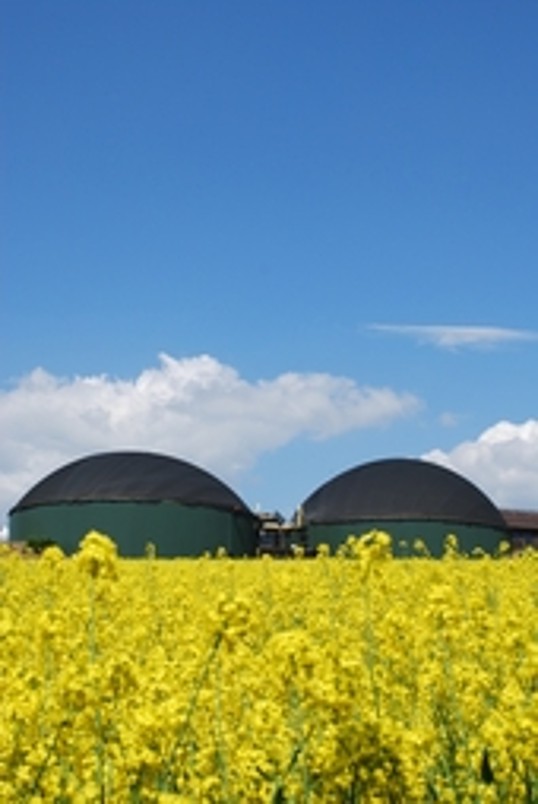The importance of explosion protection

Source: © Thomas Otto - Fotolia.com
Germany is radically overhauling its energy policy. The national government's plans are for at least 35% of the country's energy to be generated from solar, wind and other sustainable energy sources by 2020. These sources currently account for 17% of the energy supply. Biogas plants are an important element in the renewable energy mix. How can workplaces at biogas plants be made safe? The DGUV's Tim Pelzl answers questions on the subject.
What substances can be processed in biogas plants?
Pelzl: Organic substrates from a range of sources. These include renewable raw materials such as maize plants, animal excrement in liquid or solid form, or biodegradable domestic refuse.
These substrates are broken down by bacteria. The process produces biogas, which in turn is used to generate power. What substances used in a biogas plant may present a hazard to the workers?
Pelzl: Firstly, there is the biogas itself. It consists largely of carbon dioxide and methane. These substances are familiar as the primary components of natural gas. Methane is highly flammable, and forms explosive mixtures in combination with the oxygen in the air. Explosion protection is therefore of great importance in biogas plants. A further hazard is that methane and carbon dioxide may displace the oxygen from the atmosphere, presenting a risk of suffocation. For these reasons, biogas must be prevented from entering working areas. If maintenance work is necessary in danger zones, measurements must always be performed beforehand.
Toxic gases such as hydrogen sulphide and ammonia may however also occur in the plants. The proportion of these trace gases can be kept low by control of the substrate's composition. But gas alarm facilities and respiratory protective devices should be used during certain tasks, such as work performed in fermentation tanks.
Finally, hazards may be presented by the feedstock and by the digestate itself. Infectious diseases may be caused by microorganisms (biological agents) taken up via a number of routes of exposure. The intake of very high concentrations via the respiratory tract also gives rise to a risk of allergic and toxic effects. Hygiene measures, work/protective clothing, and personal protective equipment (PPE) are the first lines of defence in this case.
Can you provide an example of a "typical" hazard or occupational accident?
Pelzl: Insufficient attention is often paid to explosion protection during maintenance work. A hazardous atmosphere may form, resulting under worst-case conditions in an explosion.
Another example: respiratory protection is not worn properly during cleaning of a fermenter, causing hydrogen sulphide for example to be inhaled, and the affected individual to be poisoned.
What are the most frequent complaints?
Pelzl: If the specified hygiene and other protective measures are properly taken, complaints are not normally encountered. If however employees suffer headaches, dizziness, diarrhoea or skin irritation, the observance and efficacy of the protective measures must be checked immediately.
The observance of hygiene regulations is crucially important during work in biogas plants. Can you give examples of rules which must be observed at all times by plant operators and workers?
Pelzl: Rules apply, such as those in the German Ordinance on Biodegradable waste (BioAbfV), not only for the recycling of biodegradable waste, such as the use of digestate on agricultural land, but also for the protection of workers in biogas plants. Examples are the German Ordinance on Biological Substances (BioStoffV) and the associated TRBA technical rules 500, 230 and 214, and the TI 4 safety rule of the statutory accident insurance institutions for the agricultural sector, which was formulated specifically for biogas plants. Personal hygiene measures include the disinfection or washing of hands before breaks. Eating, drinking and smoking are all prohibited at the workplace. Work clothing must be stored separately from private clothing in accordance with good practice for preventing the propagation of pathogens; accordingly, soiled work clothing must not be taken home for washing.
An instruction video produced by the German Social Accident Insurance Institution for the energy textile electrical and media products sectors illustrates very neatly how employees can observe hygienic behaviour with little effort.
What can the employer do in order to ensure safety in the plant?
Pelzl: He must identify and evaluate hazards and define suitable protective measures whilst the plant is still at the planning stage. During operation, regular checks must be performed of whether the defined protective measures are being taken and are proving effective. Employees must receive instruction on hazards and protective measures before assuming their tasks and subsequently at regular intervals. A skin-care plan is also important. This includes the provision of facilities for washing and disinfection, and of skin protection and care products.
A number of regulations also also require that the biogas plant be inspected regularly.
An suitable image for the article can be found at http://commons.wikimedia.org/wiki/File:Manure_(DFdB).jpg
More interviews on the following topics
